| Curtiss camouflage on A.V.G. Tomahawks |
| By Rato Marczak, 2009 |
1. Introduction
During a recent modeling project I faced the new (to me) problem of choosing the correct color of the first AVG Tomahawks. This means to know which colors were used on the first 100 Hawks 81s diverted to China from British orders. This is a long shot, still subject of extensive research, mostly due to the non-matching nature of the colors used by all US aircraft manufacturers, lack of standardization during the pre-WWII years, the lack of proper communication between US and Great Britain, and also, unfortunately, the absence (so far) of conclusive documentation from USAAC/USAAF regarding lend-lease aircraft, aircraft manufacturers, as well as paint manufacturers. Of course, we don't need to go too deep inside this subject just to paint a model, but the subject is a very interesting one, and deserves highlighting at least those less argumentative points.
Furthermore, much of what is summarized herein can be applied to most US aircraft exported to the British during WWII, as far as they were painted in RAF's Temperate Land Scheme. Therefore, if you are also interested in P-38s, P-39s, A-35s, A-20s etc., this text may be useful.
I do not want to exhaust the subject - it wouldn't be possible anyway, and there's a lot of research still to be done, as well as documents to be found (hopefully). My objective was to compile the information found on a number of references to prepare a short text, yet complete enough to help you to choose the correct color of your Tiger (and similarly painted aircrafts).
2. Pre-war colors in UK - What was asked for?
RAF's Temperate Land Scheme used Dark Green/Dark Earth on upper surfaces and Sky on undersurfaces during the early years of WWII. Its creation during the pre-war years is rooted in the BS 381C. Following moves made in the paint industry in the early years of the 20th century the first range of standardized paint colors was published in 1930. After an early revision, this became known as BS 381C: 1931 Colours for Ready Mixed Paints. Even this old version already had a Sky Blue color, but the Air Ministry introduced the Sky Type S only in 1940.
Dark Green and Dark Earth are not subject of discussion, but the Sky colors are a somewhat more complex matter. For a more elaborate text on this, see my rather incomplete article RAF Skies. In what concerns the present article, suffices to mention that the American aircraft manufacturers not always had paint samples of these colors in hand, many times relying on descriptive directions to camouflage export aircraft. In addition, when paint samples were made available, an accurate description of the color and their use was not always given [3].
Therefore, the US manufacturers had a basic description of the colors and tried to match them with those produced by the American paint suppliers. Although I managed to find some scans of Berryloid (US), Sherwin-Williams (US), Pacific Airmotive (US) and Spartan (UK) pigmented dopes catalogs from the 30's and 40's for aviation industry, unfortunately I failed to find a DuPont (Curtiss' paint supplier during WWII) catalog from the same time frame. That would help to clarify many of the questions herein.
Another important (academic) aspect: the colors used on American export aircraft can be grossly divided in two periods: 1938-1942, and 1942-1945. The second one was progressively based on ANA codes defined by the Joint Aircraft Committee (JAC), although the ANA colors would appear only in mid-1943 [3]. Therefore, to establish camouflage codes based solely on ANA codes is not accurate, although it can give a good idea of them for modeling purposes. The answer is in the colors used by Curtiss to paint their Hawks 81s during 1941.
Therefore, from now on we must keep in mind three assertions (all based on factory documents / published reports):
| A1. | Colors used on American export aircraft before 1942 cannot be accurately described by ANA codes only [3] for all US aircraft manufacturers. |
| A2. | Curtiss used DuPont enamels to paint their aircraft during the 1940-1941 period [3]. |
| A3. |
The colors to be used on Hawks 81s to be exported to the British should match RAF Temperate Scheme of Dark Green, Dark Earth and Sky Type S. |
Assertions A1 and A2 need no further explanation, but what colors are those in A3? The important point here is that the British Air Ministry passed this information to the US manufacturers, but not without a plethora of misspelled color names, conflicting specs, and low or no quality control regarding color matching (see my RAF Skies aforementioned article). After all, a war was going on in Europe, and a fighter in wrong colors was better than no fighter... But it remains fundamental to answer how the US military aircraft manufacturers interpreted these colors (Curtiss, in the present case).
3. Pre-war colors in US - What was (probably) delivered?
Ok, we all know these RAF colors. Moving back to US territory, Dana Bell's Aviation Color Primers - US Export Colors of WWII (ref.[3], from which I retrieved much of the information summarized herein), is a instrumental source to determine the DuPont colors used on Curtiss aircraft. On pages 18-19, factory documents from Curtiss leave no doubts about the following DuPont paint codes used during the P-40 production:
| B1. | Dark Green: DuPont 71-013. This color is merely referred by Green on Curtiss documents. |
| B2. | Dark Earth: DuPont 71-009. This color is merely referred by Brown on Curtiss documents. |
| B3. | Sky - Type S: DuPont 71-021. Curtiss did not assign any DuPont number for this paint, but 70-021 is the color used by Bell (another user of DuPont paints) in their P-400 [3]. |
We could simply stop here and find good hobby colors for B1-B3, adding a drop of white here, yellow there and that is it. If you just want some fun modeling, go ahead. As for me, I started to study this subject and could not stop (still can't). Now it seems possible to trace some genealogy about the US colors used on military aircraft, and how they evolved during the 30's to the final ANA system of 1943.
The US Air Corps played with a number of camouflage schemes from early 20's and on. The important pre-war years that saw one or other definition of colors and systems for military aircraft are 1921, 1930, 1932, and 1933, the last being the year of the first issue of T.O.07-1-1 - Dopes, Paints and Related Material. General - Aircraft Markings, Insignia and Camouflage (see [7]). Then finally in 1938, during the GHQAF Maneuvers, the Materiel Command issued the first standardization containing color names and numbers:
1938
- Air Corps Materiel Command: water-soluble paint specification:
| 25 | White | 30 |
Dark Green |
| 26 |
Sand | 31 |
Dark
Olive Drab |
| 27 |
Light Blue | 32 |
Neutral
Gray |
| 28 |
Sea
Green |
33 |
Black |
| 29 |
Dark
Blue |
34 |
Rust
Brown |
| 35-40 |
Mystery!!! |
T.O.07-1-1 would be re-edited in May 1940. Then, in September 1940, the USAAC issued the famous Air Corps Bulletin 41 - Color Card for Camouflage Finishes. Next came Air Corps Specification 24114 of October 1940, specifying how the colors of Bulletin 41 should be applied (abandoning washable paints, ordering the use of matt colors for the first time and deleting the well known rudder stripes). The colors contained in Bulletin 41 were only eight:
1940
- Air Corps Bulletin 41: Color Card for Camouflage Finishes:
| 41 | Dark Olive Drab | 45 |
Insignia Red |
| 42 |
Medium Green | 46 |
Insignia White |
| 43 |
Neutral Gray | 47 |
Insignia Blue |
| 44 |
Black |
48 |
Identification
Yellow |
| 49 | Sand
(included later) |
The next incarnation of T.O.07-1-1, would appear in April 1941, setting the scene for the war years, again specifying the usage of colors covered by Bulletin 41. Its final edition was issued in June 1943, but we will not consider it here since the AVG would be disbanded by then.
Now let's see, the first flight of the P-40B (H-81A-2) took place on March 1941, while the 100 Tomahawks sold to China to equip the AVG (they were neither A-2s nor A-3s, strictly speaking) were shipped in late spring 1941 [10]. Therefore, Curtiss was aware of the colors from Bulletin 41. We all know that they used "US equivalents" on export aircraft (although I am not sure the term was in order by 1941), but did they actually used the Bulletin 41 or asked DuPont to mix these "equivalents"? Or did they use other colors from DuPont catalog?
Another finding is (quoting D.Bell, from [7], with my underlines): "...Although the origin of the unusual scheme of Medium Green 42 and Sand (later, Sand 49) over Sky Blue is unknown, its use is documented on Curtiss P-40s, particularly 'E' models. The pattern is identical to that used for the RAF, but the colors need explaining. An OD and Sand scheme was mentioned in tech orders and correspondence, but color slides unquestionably show Medium Green. A grayer under surface color, such as RAF 'Sky' or Neutral Gray 43 might have been logical; Azure Blue (again, RAF) would have been possible - certainly, Curtiss had made use of all three colors for P-40s! However, color transparencies show the under surface a fourth shade, a pastel blue. This color may have evolved as a second U.S. equivalent for 'Sky'...". Mr. Bell comes to this point again in ref.[3], which is seven years younger than ref.[7]. See my notes on Curtiss Sky below. However, although the use Sky or Neutral Gray might have been logical, this definitely has not materialized for H-81s with Temperate Scheme camouflage.
Summing everything up, we can now narrow our color spectrum. But before, let's list some ANA (Army-Navy Aircraft) colors from ref.[11]. Although the ANA system began officially in 1934, no standardization for it was defined before the US entered the war, hence my insistence in not using it. The ANA Bulletin No.166 was issued on December 1943, but I included the table below with some relevant colors, since in a sense they made official some colors not covered by other documents (and merged Army and Navy own schemes), and some of them may have been (and probably were) in use before 1943 by certain aircraft manufacturers. The corresponding FS595a numbers included were also retrieved from ref.[11].
1943
- ANA Bulletin 157/166:
| 502 | Insignia Blue | FS
15044 |
| 504 |
Olive
Drab |
FS
14087 |
| 509 |
Insignia Red | FS
11136 |
| 511 |
Insignia White | FS
17038 |
| 512 |
Aircraft
Gray |
FS
16473 |
| 601 | Insignia White | FS
37875 |
| 602 |
Light
Gray |
N/A |
| 605 | Insignia Blue | FS
35044 |
| 609 |
Azure
Blue |
FS
35231 |
| 612 |
Medium
Green |
FS
34079 |
| 613 |
Olive
Drab |
FS
34087 |
| 617 | Dark
Earth |
FS 30095 |
| 619 |
Insignia
Red |
FS
31136 |
| 620 |
Light Gull Gray |
FS
36440 |
Two further points before proceeding: (a) Although the aforementioned documents state that the camouflage must be airbrushed, we know that Curtiss used rubber masks at factory to camouflage their Hawks, so hard color edges was in order [8]; (b) It is commonly aknowledged that, contrary to the British military aircraft manufacturers, Curtiss didn't used A and B camouflage schemes but opted for the B scheme [7,8]. Reference [1], however, shows photographic evidences that a few AVG Tomahawks were painted in mirror scheme.
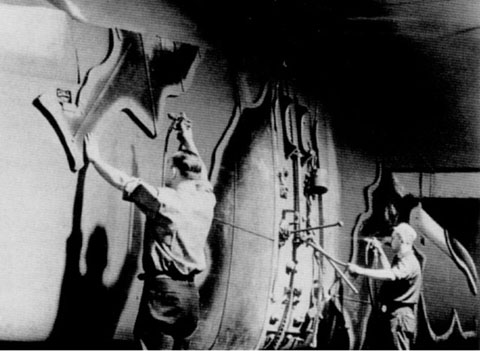
4. Looking for a Dupont-FS translation recipe
Now we are left to the task of determining which colors DuPont 71-013, -009, and -021 (and possible variations) were. Yes, we may use ANA codes to help, but our objective here is to translate DuPont colors to FS595b codes, and later find some suitable hobby colors. Let us see one by one:
Curtiss Green (DuPont 71-013):
This color has not the confusing genealogy published elsewhere, mostly due to the insistence of some authors in using ANA codes for aircraft produced before 1942. There is a consensus that FS 34092 is a good match for this color. US stocks of Dark Olive Drab 41 began to appear in mid 1940, while Medium Green 42 would appear in Sept/1940. So, these two can be initially thought as natural candidates for Curtiss' export Dark Green. Dark Green 30 is an almost perfect match for FS 34092, so it is another candidate as well. However, I believe Medium Green 42 is just the 1940 substitute for the Dark Green 30 of 1938. This is yet another possible source of confusion, as AAC Dark Green may have been confused with RAF Dark Green.
As for the Dark Olive Drab 41, many references state the use of it as a substitute for the British Dark Green, but this decision was made official only in the second meeting of the Technical Sub-Committee on Camouflage (subordinate of Joint Aircraft Committee - JAC), which happened in March, 5th, 1942. Since the sub-committee was created in Feb. 13, 1942 [3], the Army Olive Drab was almost certainly not used as a Dark Green equivalent before 1942 (it was accepted as such later, though). Since I failed to find more info on the Dark Green 30, it remains possible to think in this color or the Medium Green 42 as DuPont samples for RAF Dark Green equivalents. At least one other reputable source [11] lists FS 34079 as a Medium Green ANA 612 match.
Starting point: use a good match for FS 34079 to FS 34092, but no Olive Drab.
Curtiss Brown - DuPont 71-009:
This color is said to be close to FS 30219, and sometimes called Sandy Earth, but Curtiss actually used two colors in their RAF P-40s: DuPont 71-009 for Temperate Land Scheme and 71-065 for Desert Scheme. The former is known to fade rapidly, becoming a lighter color under the elements, while the later (approx. FS 30118, similar to Rust Brown 34) apparently had more stable pigments, and was closer to the RAF color. The 71-065 was used only on later P-40Es and on (also found on P-39s), so this paint could be a second attempt by DuPont to match RAF Dark Earth more accurately. This color should not be confused with the other desert color, Middlestone (DuPont 71-060?), used with 71-065 itself [3] in the Desert Scheme. In addition, AVG wartime photos clearly show heavily faded Dark Earth equivalents, almost a Sand color at times.
Starting point: either work with FS 30219 to obtain a good match with photos, or darken a light earth tone.
Curtiss Gray - DuPont 71-021:
This is the reason of a lot of confusion. Dana Bell [3] has elucidated much of the mess. First off, the name Sky was not forged to designate the underside colors of British fighters during the Battle of Britain. The 1931 version of the BSC 831 already had the color #1 Sky Blue. The current version (evolved from the WWII chart) contains #101 Sky Blue and #210 Sky. So the term is around for quite a while. The problem is that during WWII, the Sky color was also called Sky Type S, Duck Egg Green and Sky Type S Grey, but they were all the same color. Two other colors Sky Blue and Sky Grey also existed, and they should not be used by the Fighter Command, though were. Therefore, we have at least three colors to think about:
| C1. | Sky: This
color was proposed by the British Air Ministry in 1940 as a pale
greenish gray similar to FS 34324 [3] to be used on fighters and
bombers. The name Sky, however, was forged only later in that year.
This color was one of the new Type S (smooth) ones, hence the "Type S"
suffix. |
| C2. | Sky Blue: This was the underside color preferred by the Fighter Command. It was a pastel blue shade described as Duck Egg Blue. |
| C3. | Sky Grey: This color should have been used only on FAA and Costal Command, but it found its way on RAF fighters as well. |
Hence, leaving the Sky Grey out of the discussion (and forgetting the many non-official names), we have to worry (as the folks at Buffalo, NY had in those years) about two colors only: Sky / Sky-Type S and Sky Blue / Duck Egg Blue. Yes, they were two different colors, and many times we found photos of Spitfires and Hurricanes with their bellies painted Duck Egg Blue and the infamous fuselage identification stripes painted in Sky. In order to stop the confusion, the Air Ministry defined a directive in December 1940 stating that any instruction specifying Duck Egg Blue should be replaced by Sky. Of course, both colors lived together during quite a while.
The situation was worse in US due to poor communication with British representatives: the use of Sky Type S Grey descriptors and the 1939 color charts, which contained Sky Blue and Sky Grey colors. The consequence seems to be a very blueish color used by manufacturers assuming the Sky Blue (like North American and Douglas) and light gray for those assuming Sky Grey (like Curtiss, Lockheed and Vultee). To make things worse, some manufacturers broke this weak rule (of mine) more than once. For instance, Grumman used DuPont 70-021 for its interpretation of Duck Egg Blue, but the same DuPont 70-021 was used by Bell to paint their P-39s undersurfaces in "Sky Type-S Grey".
Curtiss did not mention the color code in their known painting instructions. I am assuming that they used 70-021 because Dana Bell did so, and this is supported by the fact that both, Curtiss and Bell used DuPont colors, Bell clearly specifying 70-021...
Which color is this? To the best of my knowledge, there is no good FS match. DuPont 70-021 is a greener version of FS 35526 and a bluer version of FS 35414. Reference [8] suggests FS 36463. Whatever it is, I'm betting the color used by Curtiss on export aircraft has nothing to do with Neutral Gray 43 shade. There are several photos showing P-40s undersurfaces painted with DuPont 70-021 and retouched with Neutral Gray - the difference is too notorious to be attributed to fading, not to mention these are under surfaces.
Starting point: FS 36463 is a good starting point but FS 36622 is a better match to the photos. Do not use Neutral Gray.
5. From analog to digital
Now it is time to play a bit with digitalized photos. I worked on a few color photos to bring them to what I think is a better color definition on a computer screen. The photos were retouched to remove purple or yellow hues from the sky. I have not tried to bring the aircraft colors in these photos closer to any of the shades discussed. However, I deliberately changed the saturation of the whole images as an attempt to reduce the effect of light diffraction, since my color samples are not optically affected by that. Once satisfied (and personal tastes aside), I overlaid digital color samples to the images. I hope that this will help to draw better conclusions on the subject. Of course, I was not expecting even close matches, just hints to eliminate plain wrong colors.
Besides the references listed at the end of this article, Urban Fredriksson's Color Reference Charts - Part I and Part II and the United States Federal Standard 595a/595b color server were used to produce the digital color chips. They are among the best online resources for this purpose.
DuPont 71-013: I used the generally accepted FS 34092 and FS 34079 of ref.[11] as close matches for Medium Green 42. Dark Olive Drab 41 and RAF Dark Green are also included for comparison using their close matches FS 34096 and FS 23070, respectively. After overlaying the Medium Greens with the color images, I found out that the correct color may be somewhere between FS 34092 and FS 34079.
DuPont 71-009: FS 30219 (Sand Earth) was used (crossing my fingers that it is close enough to Sand 49) along with FS 30118 for Rust Brown 34. RAF Mid Stone used on Mediterranean was included as FS 30266, as well as FS 30095 as a generally accepted match for RAF Dark Earth. My experiments showed that FS 30219 is indeed an excellent match, even taking into account the heavily faded colors on operational AVG Hawks.
DuPont 71-021: The FS colors used in this case were FS 36463 as suggested by ref.[8], but I also used an old guess of mine, the FS 36622 to reduce the blueish aspect of these colors, as per wartime photos. Other colors used for comparison were FS 36173 playing the Neutral Gray 43, as commonly suggested, and FS 36440 to see if ANA 620, Light Gull Gray as per ref.[11], could have had something to do with the genesis of this color. Color photos showing the under surfaces of AVG Tigers are rare, so I used some RAF P-40Es as an extra aid. I decided for FS 36622.
These colors are grouped in the image below. The chosen candidate DuPont colors are centered (with red numbers) for comparison:

My first test was carried out to eliminate any doubts about the Dark Olive Drab 41 on export aircraft. For that, I used a photo from Curtiss factory published by Life Magazine [12], showing P-40Bs for USAAC. In that case, Olive Drab 41 is the correct color so my 71-013 green should not match. Here is the result:
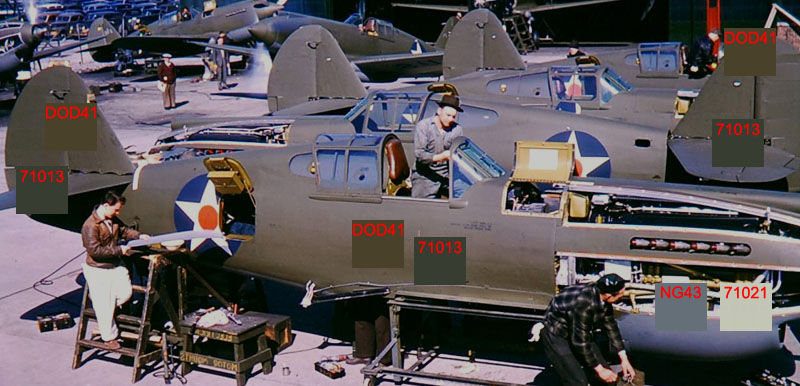
Clearly, the Olive Drab 41 is in agreement with the image, while the 71-013 green is not. Ok, so do not insist in using Olive Drabs for your AVG Tigers... For the next tests, I will show the original image on the upper side and the retouched image on the lower side, with my DuPont colors interpretation superimposed. In any case, I kept the Olive Drab in the game for comparison.
This is a well-known photo of Hawk #49 (P-8133) in flight. I reduced the blue hue of the original negative, since even the ground was bluish:
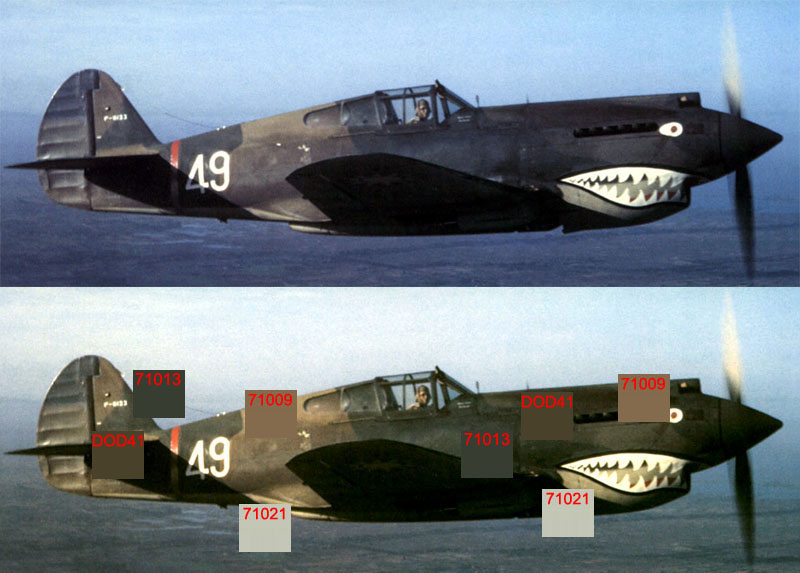
It is evident that our 71-013/71-009 is doing well in this comparison. The 71-021 is not, but the under surfaces are obviously receiving less light. The Dark Olive Drab can not get even close to the green, being more to the brown side...
The next one is another famous color photo: Hawk #68 (P-8109) with the sun almost directly over it. All I did was to reduce the purple from shadows and mid-tones:
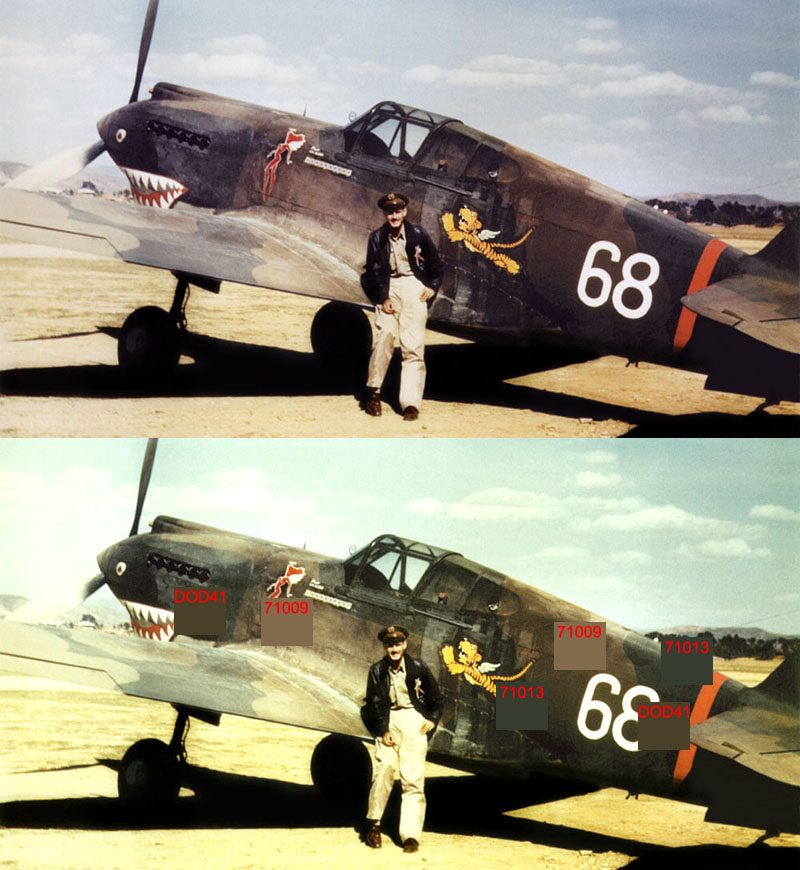
Again, our 71-013 seems acceptable, as is the 71-009, although still a bit too brownish. The Olive Drab is off again.
Now here is R.T. Smith checking out Hawk #40 (serial unknown) after its transfer from the second to the third squadron (photo modified from The Hawk's Nest):
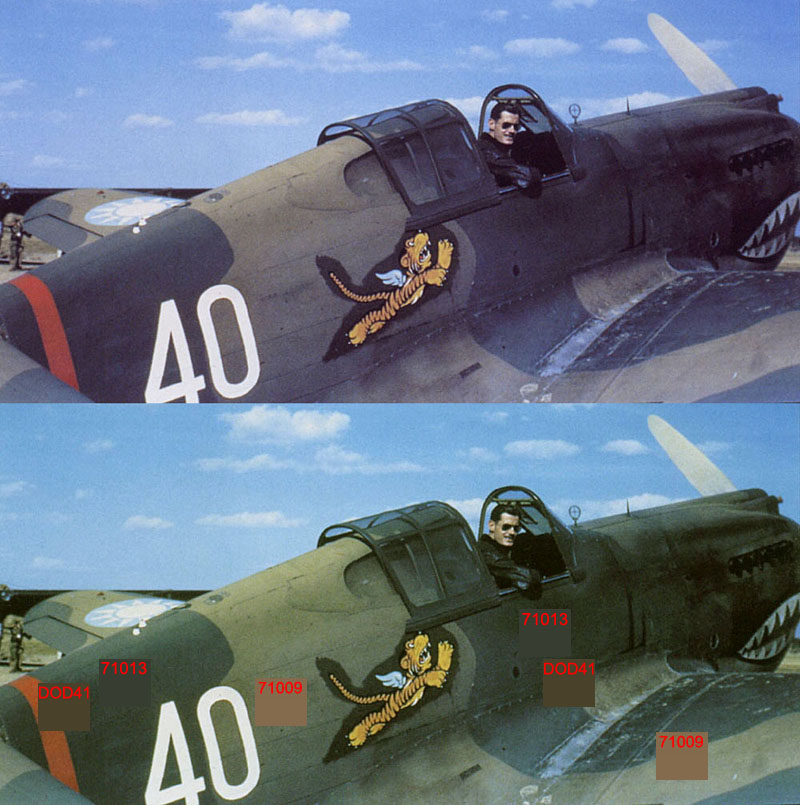
The 71-009 seems off in this particular case, but we have to recall the D.Bell's comments about the fading prone nature of the first Curtiss brown attempt. Our 71-013 performed better, though. Also of note are the replaced panel on the wing root and the sharp color demarcation. And of course, there's a lot of dirt and scratches everywhere.
Another interesting test is to compare our chips with the P-40B on loan to the National Museum of Naval Aviation in 2004. This bird is said to have many engine panels preserved in original paint (except for the shark mouth). Hence, it is a good test since this is a modern digital photo not changed by any means (photos by Steven Stohr):
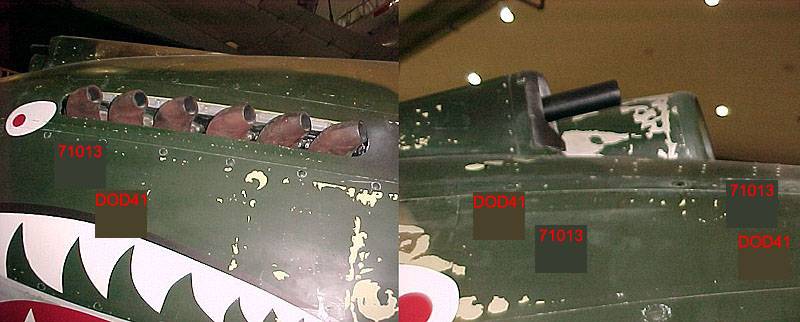
This same aircraft photographed from another angle (photo by Scott Murphy):
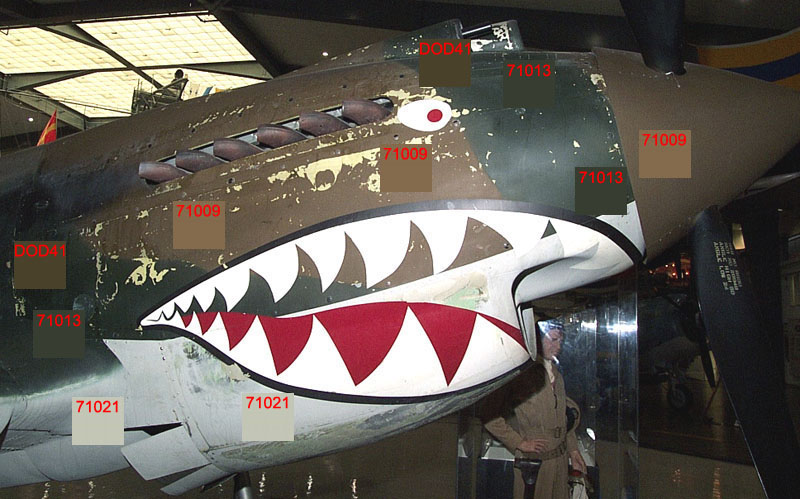
I am pretty satisfied with both DuPont Green and Brown, although I would bring my green more to the FS 34092 side for a better match with the photos. The FS 34079 color it tad too olive. The gray seems ok, but it lacks a bit of blue, so FS 36440 would be still in the game. In order to help to elucidate these small discrepancies, I took an early RAF P-40E photo, not sure it was painted with the same DuPont shades. Here's what I got:
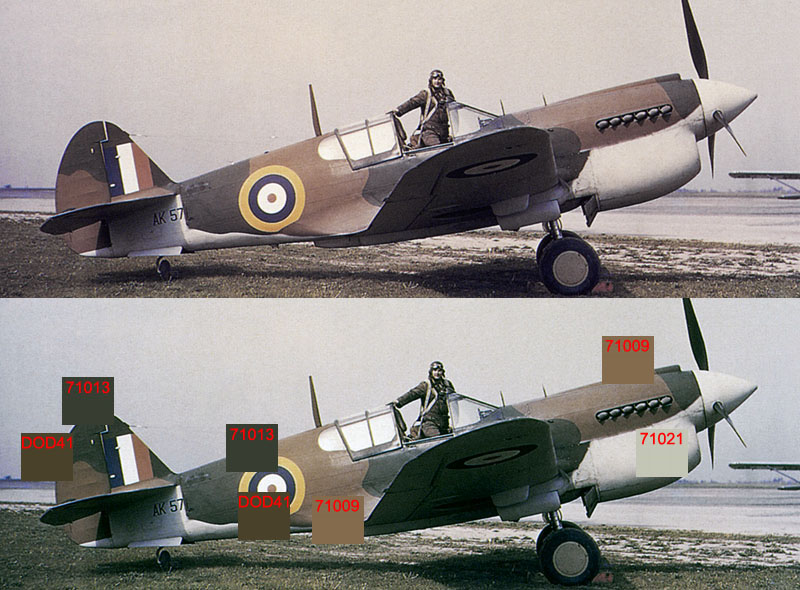
As you can see, in this test our 71-021 performed slightly better. In addition, the brown color may be 71-065 instead of 71-009.
6. Back to the workbench
Now I have the ingrate task of finding good hobby colors for these samples. I have not done any professional kind of test, just played with the colors I had in hand, but I also included some suggestions dug from the internet, hobby colors catalogs, Urban Fredriksson's Color Reference Charts - Part I, Part II, and The Ultimate Model Paint Conversion Chart of Aaron Spilling (I'm using their respective symbols to denote each color/brand).
DuPont 71-013:
Urban Fredriksson's Color Reference Charts:
| Colour name | Comment | Humbrol | Tamiya | Xtracolor | Polly S | Gunze Sangyo | Model Master |
| FS:33070 | Olive | 8*Hu:150 + 4*Hu:10 + 2*Hu:154 | |||||
| FS:34079 | Leaf Green | Hu:116 | T:XF-27/61? |
X:X110 | P:PCA814/835 | GS:H309 | MM:1710 |
| FS:34087 | Olive Drab | 3*Hu:163 + 4*Hu:108 + 1*Hu:33 (155, 3*Hu:163 + 4*Hu:108 + 3*Hu:33) | T:XF-62? |
X:X111 | P:832/808/819 | GS:H304 | MM:1711 |
| FS:34092 | Extra Dark Sea Green | Hu:149 | T:XF-27*2 + 22*1 | X:X114 PCG862 | GS:H302 | MM:1764 | |
| FS:34095 | Dark Grey Green | 2*Hu:80 + 1*Hu:117 | |||||
| FS:34096 | Nivo | 6*Hu:116 + 6*Hu:117 + 1*Hu:163 | T:XF-61 | ||||
| FS:34102 | Forest Green | Hu:117 | T:XF-61*2 + 65*1 | X:X116 | P:500815 | GS:H303 | MM:1713 |
The Ultimate Model Paint Conversion Chart:
| Colour name | Model
Master Enamel |
Model
Master Acryl |
Vallejo | Humbrol | Tamiya |
Gunze
Sangyo Aqueous |
Gunze
Sangyo Lacquer |
Revell Enamel |
White Ensign Enamel |
|
| FS:33070 | ||||||||||
| FS:34079 | 4726 | 892 (87) | 163 | 330 | AC RN 09 | |||||
| FS:34087 | ||||||||||
| FS:34092 | 1764 |
4729 |
894
(96) / 895 (88) |
149 |
XF-26 |
302 |
302 |
67 |
AC US 16 | |
| FS:34095 | 1786 |
E5941 |
823
(86) |
2 |
X-05 |
61 |
||||
| FS:34096 | 1571
/ 2027 |
892
(87) / 897 (98) |
114
/ 30 / 161 |
XF-13
/ XF-61 |
36
/ 73 / 320
/ 60 |
17
/ 23 / 320 |
AC
RS 06 |
|||
| FS:34102 | 1591 |
4734 |
890
(90) |
86 |
XF-58 |
303 |
303 |
45 |
AR
US 08 |
Other suggestions:
| Colour name | Model
Master Acryl |
Humbrol | Tamiya | Xtracolor | Polly S | Gunze Sangyo | |
|
|
| FS:33070 | |||||||||
| FS:34079 | 116 |
XF-13 | H309 |
||||||
| FS:34087 | XF-51 | ||||||||
| FS:34092 | 4729 |
XF-61 | H304 |
||||||
| FS:34095 | |||||||||
| FS:34096 | |||||||||
| FS:34102 |
DuPont 71-009:
Urban Fredriksson's Color Reference Charts:
| Colour name | Comment | Humbrol | Tamiya | Xtracolor | Polly S | Gunze Sangyo | Model Master |
| FS:30219 | Red Brown | Hu:118 (119) | T:XF-52 | X:X102 | P:PCA816/874? | GS:H310 | MM:1742 |
| FS:30266 | Mid Stone | 3*Hu:81 + 2*Hu:26 | T:XF-60 | P:PCA818 |
The Ultimate Model Paint Conversion Chart:
| Colour name | Model
Master Enamel |
Model
Master Acryl |
Vallejo | Humbrol | Tamiya |
Gunze
Sangyo Aqueous |
Gunze
Sangyo Lacquer |
Revell Enamel |
White Ensign Enamel |
|
| FS:30219 | ||||||||||
| FS:30266 |
Other suggestions:
| Colour name | Model Master | Humbrol | Tamiya | Xtracolor | Polly S | Gunze Sangyo | White Ensign Enamel |
|
|
| FS:30219 | H66 |
||||||||
| FS:30266 | AC US
05 |
DuPont 71-021:
Urban Fredriksson's Color Reference Charts:
| Colour name | Comment | Humbrol | Tamiya | Xtracolor | Polly S | Gunze Sangyo | Model Master |
| FS:36440 | Lt Gull Grey | Hu:183
(129) Hu:129 (183) |
1*T:XF-20 + 1*T:XF-2 | X:X137 | P:PCA825 | GS:H51? GS:H325/H315 |
MM:1729 MM:1730 |
| FS:36492 | Light Grey | 8*Hu:34 + 1*Hu:156 + 1*Hu:28 | X:X147 | ||||
| FS:36622 | Light Grey | Hu:28 (97) | T:XF-19 | X:X140 | P:PCA817 | GS:H311 | |
| FS:36628 | 9*Hu:34 + 1*Hu:64 |
The Ultimate Model Paint Conversion Chart:
| Colour name | Model
Master Enamel |
Model
Master Acryl |
Vallejo | Humbrol | Tamiya |
Gunze
Sangyo Aqueous |
Gunze
Sangyo Lacquer |
Revell Enamel |
White Ensign Enamel |
|
| FS:36440 | ||||||||||
| FS:36492 | 2038 |
989
(154) |
196 |
XF-66 |
371 |
|||||
| FS:36622 | ||||||||||
| FS:36628 | 993 (151) |
Other suggestions:
| Colour name | Model Master | Humbrol | Tamiya | Xtracolor | Polly S | Gunze Sangyo | Model
Master Acryl |
Vallejo |
|
| FS:36440 | 21*Hu:34 + 5*Hu:27 + 2*Hu:29 | ||||||||
| FS:36492 | |||||||||
| FS:36622 | 1733 |
XF-20 |
505090
/ 505380 |
H012 |
4763 |
045
/ 051 |
|||
| FS:36628 |
The hobby color tables above were not tested, so I cannot say anything about their accuracy. If you don not have the bottle of a particular brand, use one of the many hobby paint conversion charts available on the internet.
What I did was to test a number of colors and brands readily in hand from my stash. Some of them are in the tables above, but I could not resist and tested a few more. As usual, the photos below cannot capture precisely the hues, but they are not much off. Remember that these were taken under my very limited budget workbench studio, so they are no good substitute for the real samples.
The greens proved an old modeling saying: "Don't believe in what you see through the paint bottle". That is one color. After mixing, it is another. After brushing, it becomes another. Yet another color after it dries.
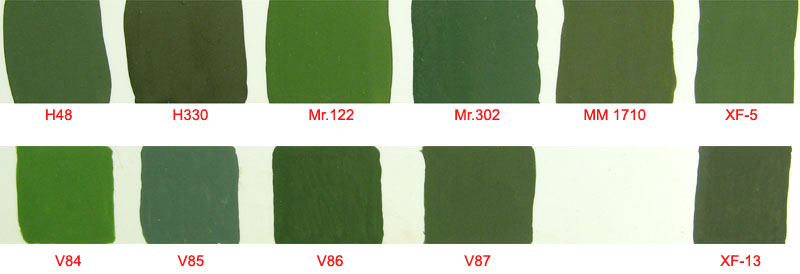
H:Gunze Aqueous; Mr.:Gunze lacquer; MM:Model Master; XF:Tamiya; V:Vallejo (position number).
From what I was able to check, Gunze Mr.Color 302, Vallejo 86 and Tamiya XF-5 and XF-13 are good colors to start with. I probably would suggest using XF-13 with a touch of yellow or light gray. The browns were virtually all usable, except for Gunze Aqueous H-81:
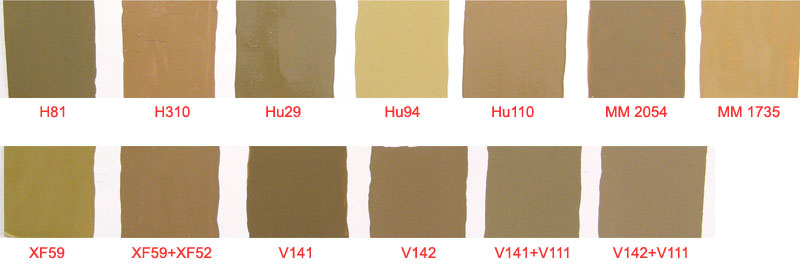
H:Gunze Aqueous; Mr.:Gunze lacquer; MM:Model Master; XF:Tamiya; V:Vallejo (position number).
I liked the shades of Model Master 1735 and Humbrol 110 mixed with 94. The combination of Tamiya XF-59 and XF-52 produced a very good "factory fresh" 71-009, as did Vallejo 142 mixed with 111 (both are a bit too dark, though).
I confess I was not satisfied with any of these colors. Something was off in both, the browns in particular. I made a few more tests (including Revell and Pactra colors), and all that was driving me crazy. I finally put my arrogance in the bag and rode for help from the experts. After a phone call, my friend Sandro Tomaseto set up a meeting at his house, and called Luiz Amaral Bandeira, both well known modelers of our area, particularly for their eagle eye for mixing colors and weathering. Sandro received me at his door by saying, "Let's do it. And don't worry, because greens/browns are the most difficult combination of colors in modeling!". He even made his paints available. After a long talking about the hues behind these colors, Sandro started mixing the brown. Using Gunze lacquers, he started with Dark Earth and added Sail until he was satisfied. Yep, simple as that, and I must confess that the shade obtained pleased my eyes more than any of my previous mixes. Amaral also brought his 1/72 Hasegawa P-40E to illustrate his interpretation of these colors, although I still think his brown seems to reproduce better DuPont 71-065, and not the 71-009. As for the green, after testing various formulas Sandro ended up with two acceptable colors: Revell 363 + 91 and Tamiya XF-13 + XF-5 + XF-21, both recipes with roughly the same amount of components. Here is Sandro preparing the samples at his workbench along with Amaral's P-40:
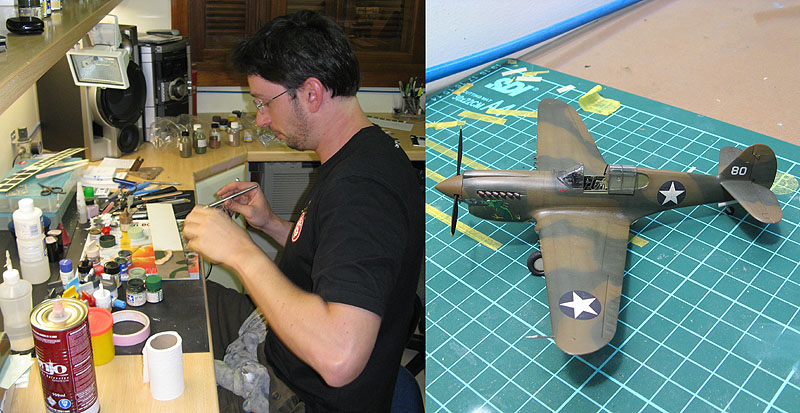
How could I think of adding Sky to my green mix? A big thank you Sandro and Amaral. Back at home, I realized that I did not have all the colors Sandro used, and I had to improvise a bit. Armed with the samples painted during our jam section, I prepared these rather unorthodox formulas for DuPont 71-013 and 71-009, respectively:
Green (Gunze Sangyo aqueous): 5*H304 + 4*H85 + 1*H51 + 1*H81 and add a few drops of H27.
Brown (Tamiya acrylics): 5*XF-13 + 3*XF-5 + 1*XF-21.
These colors are starting points, and I am aware that under your eyes they may (and probably will) need corrections. Good luck. All I needed were tones that will change considerably with post shading, washes and pigments. Here are the recipes above painted on a piece of scrap:

The grays did not need any test. Not having Model Master 1733 to check, I simply decided for a bottle of FS 36622 Aerotech automotive lacquer (at the time of writing, I had already painted the underside of my model with this color). Vallejo also has a good number of grays in their line... it is worth to check it out.
Scale effect is your problem. Use complementary colors to enlighten the basic tone depending on your personal liking and the scale of the model. Anyway, I cannot (and will not try to) be conclusive here, at the risk of contradicting some modelers. As I said before, there are too many things to consider when painting a model.
7. Verdict
In summary, after a bit of research we tried to find good Federal Standard matches for some color photos, and now all we have to do is to choose our favorite color brand and mix our DuPont colors using the recipe:
DuPont 71-013: Following the comments on section 5, I would recommend 2 parts FS 34092 and 1 part FS 34079, in order to reduce its olive hue.
DuPont 71-009: FS 30219
DuPont 71-021: FS 36622
Of course, this is a suggestion. Keep in mind that we are using the FS system here merely to find reasonable colors. Quoting Steven "Modeldad" Eisenman: "...FS chart is only an approximation. It did not even exist during the WW2". Sometimes we simply can't find a close match. However, I think FS colors are excellent starting points to prepare a given shade, which can be corrected by adding a drop of this color or two of that other.
But what is a close match, after all? Needless to say, we always look for a ready made paint (not everyone has much fun in mixing paints), but you may not find a color close enough for your taste, and that happens pretty often to me. What is good for one modeler may not be for another, I won't make any attempt to argument on the artistic side of the hobby. Besides, there is the pre-shading, post-shading, scale effect, washes, fading, filters, pigments, you name it. All these things can push a good color to the wrong side, or instead, bring a wrong one to a more acceptable point. Why all the research, then? Because I like the historical background of this kind of stuff. If I convinced you not to use RAF's Dark Green, Dark Earth, nor USAAC Olive Drabs and Neutral Grays on your AVG Hawks, my job is done.
Obviously, I had no intention to exhaust the subject. This is a text permanently in progress, and I am gladly receiving any kind of contributions, suggestions, criticism or corrections from you anytime.
8. Further questions
Finally, I will stand corrected and put this article in the garbage basket if anyone appears with a copy of DuPont paint catalog of late 30's/early 40's contradicting anything written here. Some things were educate guesses, hence a few questions persist:
(a) Did Curtiss actually used the Bulletin 41 or asked DuPont to mix their interpretation of "US equivalents"? Or did they use other colors from DuPont aviation paint catalog?
(b) Which are the ready-made colors in DuPont catalogue at the time?
(c) Did ANA colors have something to do with aircraft manufacturers color specs? How was the genesis of each color?
(d) Which paints were used by AVG ground crew to retouch their Hawks?
(e) Did Curtiss actually try two types of browns? Did they actually noted the fading problem with 71-009 or simply switched to another color (71-065)?
I am looking forward to hear from you.
References
1. Clements, T.: AVG Colours and Markings, Osprey's Aircraft of the Aces #41, Osprey Publishing Ltd., 2001.
2. Tullis, T.A.: Tigers of China - The Aircraft of the A.V.G., Eagle Files #4, Eagle Editions Ltd., 2001.
3. Bell, D.: Aviation Color Primers No.1: US Export Colors of WWII, Meteor Productions, 2002.
4. Aircraft Colour Chart - USAAF Aircraft (WWII - European Theater), Iliad Design, 2005.
5. Aircraft Colour Chart - USAAF North Africa Camouflage, Iliad Design, 2005.
6. Aircraft Colour Chart - RAF Day Fighters (WWII - Northern Europe), Iliad Design, 2005.
7. Bell, D.: Air Force Colors - Volume 1, 1926-1942, Squadron/Signal Publications, 1995.
8. Bridgwater, H.C.: The Curtiss P-36 and P-40 in USAAC/USAAF Service 1939 to 1945, Combat Colours #3, Guideline Publications, 2001.
9. BS 381C - Specification for colours for identification, coding and special purposes, British Standard Institute, 1996.
10. Dann, R.S.: P-40 Warhawk, In Action No.205, Squadron Signal Publications, 2007.
11. Elliott, J.M.: The Official Monogram US Navy & Marine Corps Aircraft Color Guide, vol.2 - 1940-1949, Monogram Aviation Publications, 1998.
12. Life Magazine digital archives.
Rato Marczak © 2009
